38 Latest Artificial Intelligence Statistics For 2024
Welcome to our roundup of artificial intelligence statistics.
It’s been an exciting year for AI.
Recently, new technologies like GPT-4 and Midjourney have generated a wave of public interest. And this public interest has accelerated global investment in and adoption of AI technology.
In this post, we’ll be sharing some eye-opening artificial intelligence stats that highlight the current state of AI this year, how AI software is being used, the challenges facing the sector, and more.
Editor’s picks
- The AI industry is predicted to be worth more than half a trillion dollars by 2024 (Statista2)
- Around 35% of companies are currently using AI (IBM)
- The top use case for AI is to increase operational efficiency (Dataiku)
- AI can increase lead generation by as much as 50% (ProfitBlitz)
- ChatGPT reached over 100 million MAUs in 2023 (Reuters)
- Almost 30% of leading brands now use AI for marketing (Adam Connell)
- Over ¾ of people are concerned about losing their job to AI (Forbes Advisor2)
- 23% of customer service companies are now using AI chatbots (Blogging Wizard)
General artificial intelligence statistics
Let’s start by looking at some general artificial intelligence statistics that reveal the current size of the market and its growth over time.
1. The global AI industry is predicted to be worth over half a trillion USD by 2024
AI was the center of a lot of hype in 2023, and many experts predict that the industry will continue to grow in the coming years.
According to statistics published on Statista, the global AI market will be worth half a trillion dollars by 2024. The same study also predicts that the market will be worth a whopping 1.5 trillion USD by 2030.
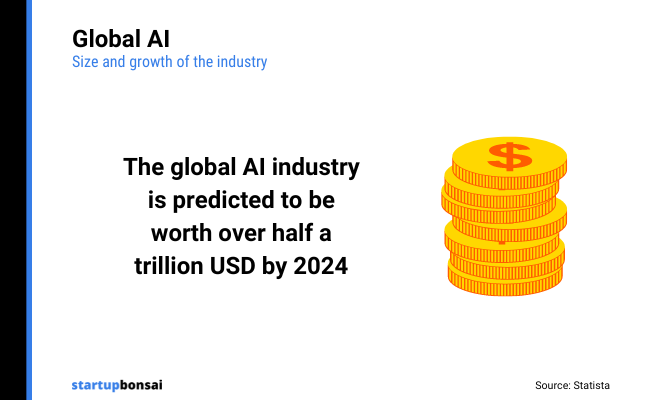
Source: Statista2
2. Global spending on AI will reach $301 billion by 2026
This is according to industry estimates published in a report by Dataiku and represents a 5-year compound annual growth rate (CAGR) of 26.5%.
For context, as of 2023, global spending on AI currently stands at a little over $150b. That means it’s expected to double over the next 3 years.
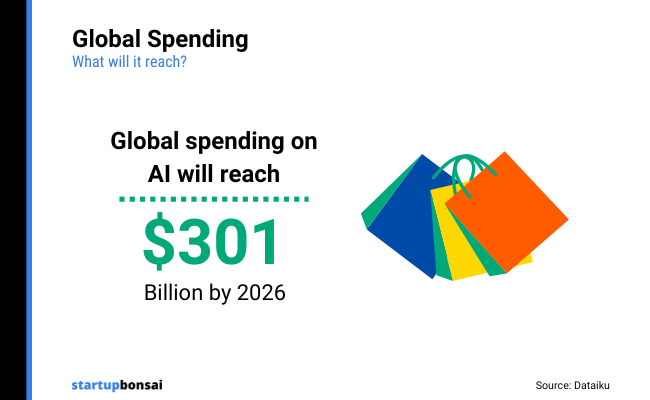
Source: Dataiku
3. Private investment in AI increased by 1700% from 2013-2022
In total, global AI private investment stood at around $91.9 billion last year. While this is 17x higher compared to what it was a decade ago, it’s interesting to note that it’s actually 26.7% lower than in 2021.
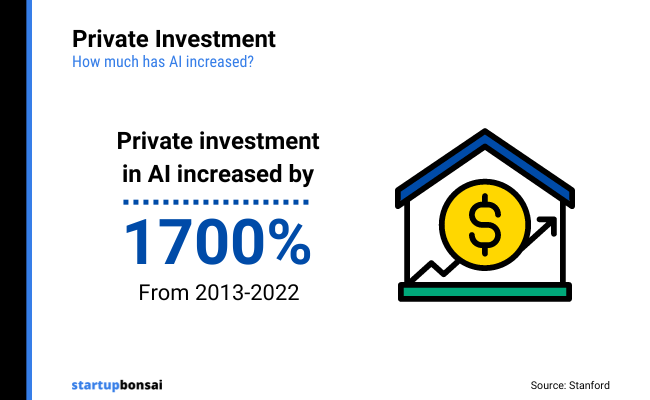
Source: Stanford
4. 78% of Chinese citizens feel positive about AI (more than any other country)
In a 2022 survey, people across the world were asked whether they agree that the use of AI has more benefits than drawbacks. In China, 78% agreed, making it the country that feels most positively about AI.
In comparison, only a little over 35% of surveyed Americans agreed that there were more benefits than drawbacks. It could be said, then, that Americans are less than half as likely to feel positive about AI than Chinese citizens.
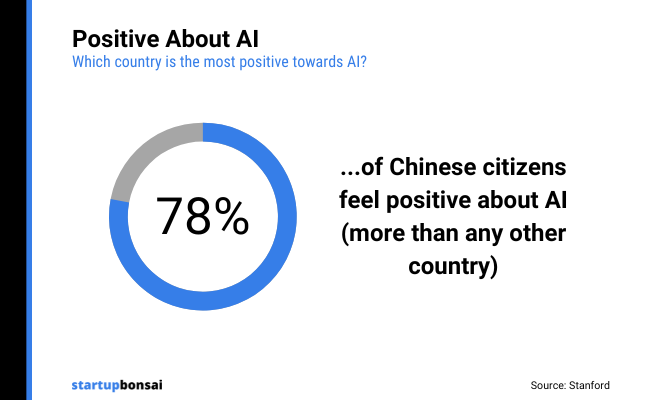
Source: Stanford
5. The banking sector spends more on AI than any other industry
Just four industries are responsible for over half of all global IT spending on AI: Banking, retail, professional services, and manufacturing. Of these, banking is the industry that spends the most overall, with the retail industry a close second. In total, the banking sector is estimated to spend over $40 billion on AI by 2026.
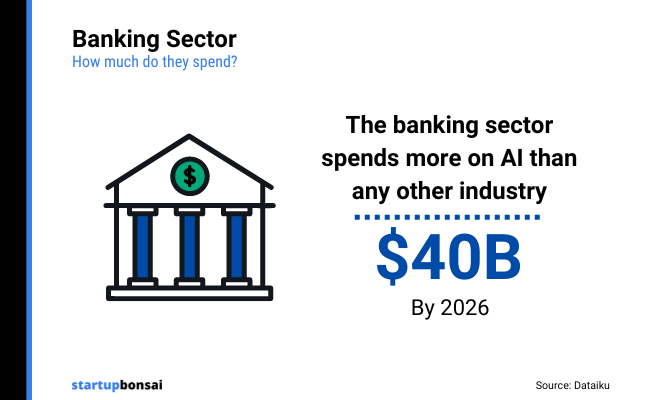
Source: Dataiku
6. AI-related job postings increased to 1.9% in 2022
A report from Stanford found that the percentage of job postings featuring AI-based skills increased from 1.7% in 2021 to 1.9% in 2022.
This highlights the increasing demand for AI-related professional skills. If you want to improve your career prospects in the future, now may be the time to upskill and start learning to work with AI.
Source: Stanford
AI adoption & usage statistics
AI is changing the way businesses operate across the board. Here are some key statistics that shed some light on how many companies are adopting and making use of new AI technology.
7. 35% of companies now use AI
That’s according to a report by IBM from 2022. In addition to the 35% that already use AI, 42% more are exploring it, so we can expect adoption to continue to grow into the future.
Source: IBM
8. The top factor driving AI adoption is increased accessibility
43% of surveyed professionals say the top factor driving AI adoption is new advancements in AI making it more accessible. Other top factors driving adoption include the need to reduce costs (42%) and competitive pressure (31%).
Source: IBM
9. 28% of the world’s leading brands use AI for marketing
The use of AI isn’t limited to niche and revolutionary companies. In fact, big named brands are already adopting the use of AI in order to streamline their business processes. According to the data, around 28% of leading brands are currently using AI to enhance their marketing efforts.
Source: Adam Connell
10. 39% of businesses who use AI say the main reason they do so is to improve operational efficiency
This makes improving operational efficiency the top use case for AI. A further 38% said their primary business objective for using AI is to improve the customer experience, while 37% said it’s to improve employee productivity, 36% said it’s to increase innovation, and 35% said it’s to improve sustainability.
Source: Dataiku
11. Almost ¼ of customer service companies use AI-powered chatbots
One of the biggest use cases for AI is to lessen the load on customer service representatives. Many AI tools now have the power to answer simple, repetitive customer queries and offer support, which is why 23% of customer service companies are already using AI to power their chatbots.
Source: Blogging Wizard
12. 16% of surveyed organizations plan to build or deploy AIOps in the next 2 years
AIOps stands for artificial intelligence for IT operations and is all about automating IT processes.
This was the top response by surveyed businesses when asked what AI solutions they’re looking into over the next 2 years.
Other popular types of AI solutions organizations plan on deploying over the next 2 years include augmented intelligence (15%), discovery and analysis applications (14%), intelligent task or process automation (14%), preventive maintenance (14%), and computer vision (14%).
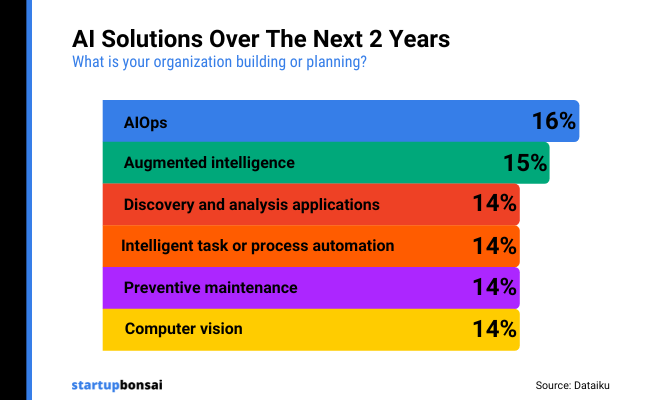
Source: Dataiku
13. 84% of businesses believe they need AI to achieve their growth objectives
As AI grows in popularity, many companies are seeing the use of AI as an essential step that they need to take in order to reach their growth goals. 84% of executives told Accenture that they believe they need AI in order to continue growing.
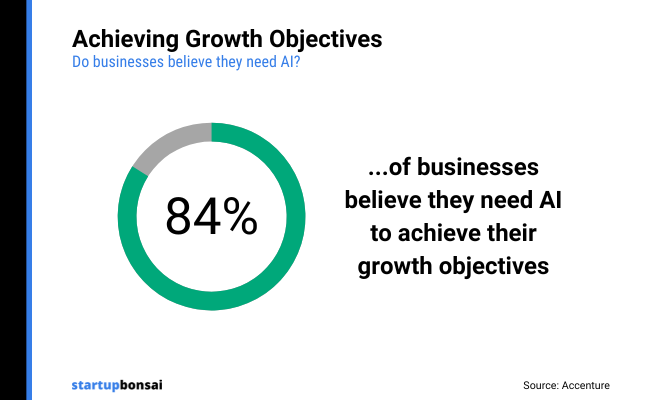
Source: Accenture
The benefits of artificial intelligence
Now we know how businesses are using AI, let’s take a look at some statistics relating to AI benefits.
14. Businesses that have invested in AI have seen a 35% increase in innovation, on average
Daitaku survey asked surveyed businesses to put a figure on how much investing in AI has improved different business outcomes over the past 3 years. Globally, respondents said innovation had improved by 35% on average.
There was also a 33% average improvement in sustainability, a 32% increase in customer and employee retention, and a 31% increase in operational efficiency.
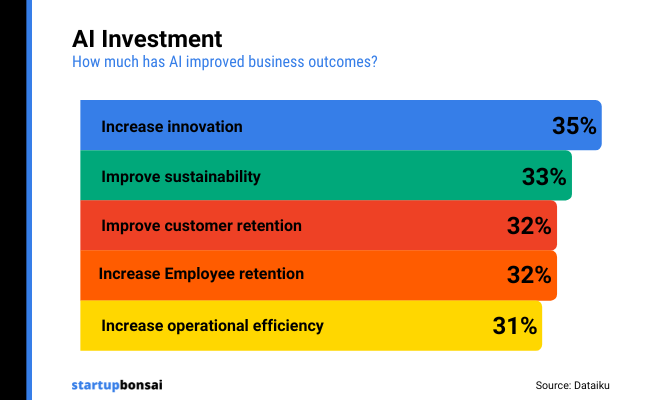
Source: Dataiku
15. AI has been proven to increase leads by as much as 50%
AI can have a huge positive impact on lead generation. According to statistics compiled by ProfitBlitz, marketers that use AI for lead generation have seen as much as a 50% increase in leads. The same post found that the use of AI can also decrease costs and call times by as much as 60%.
Source: ProfitBlitz
16. 30% of global IT professionals say AI is saving their organization time
Artificial intelligence can be used to automate repetitive processes and streamline operations. This can lead to huge time savings, particularly in IT. By using AI in your IT processes, you can free up time for your IT staff to focus on more important tasks.
Source: IBM
17. 54% of surveyed organizations report seeing cost savings and efficiencies from using AI
As this stat shows, it’s not just time that AI can save for your business, it’s also costs. By outsourcing tasks to AI technology, you can cut down on labor costs.
Source: IBM
18. 53% of surveyed organizations report improvements in IT or network performance from using AI
Aside from time and cost savings, AI can also lead to direct improvements in business performance, particularly in IT.
Source: IBM
19. 48% of surveyed organizations report improvements in the customer experience from using AI
There are lots of ways in which AI can improve the customer experience. For example, AI tools can be used to analyze customer data more effectively at scale, then use this data to provide more personalized content, offers, and product recommendations.
Source: IBM
20. 64% of business owners believe AI will increase productivity
Increasing productivity is one of the biggest benefits of using AI. Tasks that don’t require a lot of human intervention can easily be streamlined or automated using AI. According to Forbes Advisor, around 64% of business owners see this as one of the biggest benefits of AI.
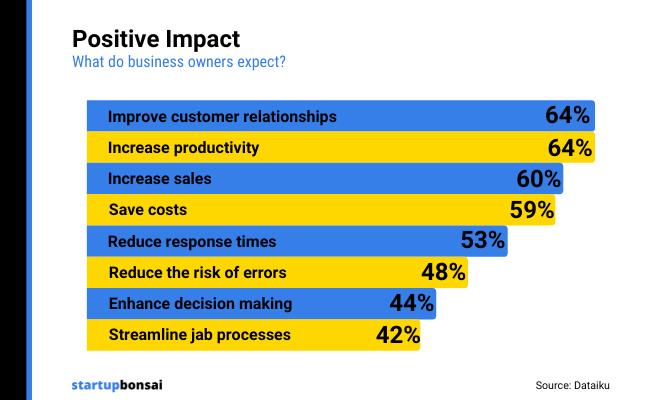
Source: Dataiku
21. 64% of businesses believe that AI will have a positive impact on customer relationships
Another popular benefit of AI is the positive impact that it can have on customer relationships. Using AI can help you to improve wait times and offer better, faster support, which all leads to increased customer satisfaction. Forbes Advisor found that 64% of businesses believe this is one of the biggest AI benefits.
Source: Forbes Advisor
22. 53% of companies have seen improved production processes thanks to AI
AI has a ton of different use cases, and business owners are using it in many different ways to benefit their business management. One of the biggest improvements that business owners have seen since using AI is an improvement in production processes.
53% of businesses in a Forbes study reported this improvement. The same study found that AI usage can also improve SEO (52%) and process automation (51%).
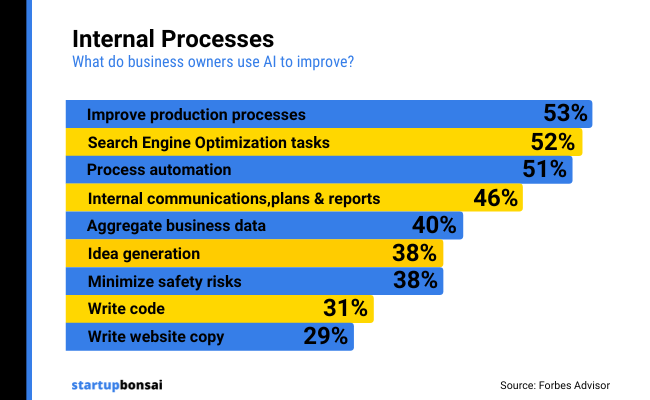
Source: Forbes Advisor
23. 38% of businesses say AI helps them to minimize safety risks
Another big benefit of using AI is that it can help to minimize safety risks. According to Forbes Advisor, 38% of businesses have seen an improvement in safety risk minimization thanks to AI.
Source: Forbes Advisor
AI software statistics
The development of AI software is on the rise, and there are tons of new AI tools out there to choose from. Here are some AI statistics that shed some light on the most popular software on the market.
24. ChatGPT is the most tried AI tool in the US
According to Statista, 20.9% of U.S. respondents have used ChatGPT and 89% would use it again. The second most tried AI tool was JaperChat, followed closely by GetGenie.
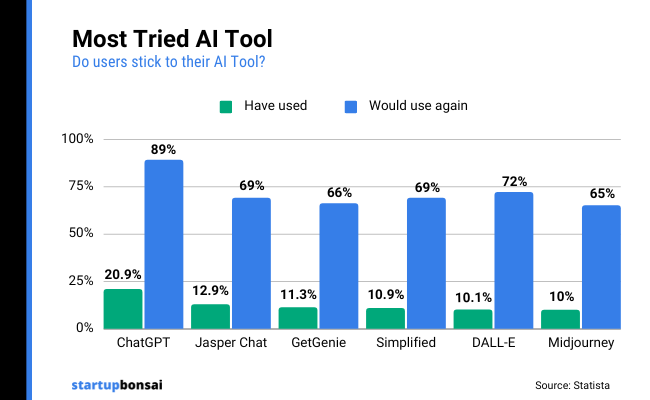
Source: Statista
25. ChatGPT reached 100 million monthly active users in January 2023
ChatGPT is by far the most talked about AI tool to be released so far. Its advanced capabilities gave it viral potential across social media platforms which created a surge in usage that the company struggled to manage. According to Reuters, the tool had around 100 million active users in Jan 2023, making it the fastest-growing app in internet history—faster, even, than TikTok.
Source: Reuters
26. 67% of people would use ChatGPT as a search engine
When ChatGPT was released, it signaled a shift in the way people use AI. Instead of just being used as a streamlining tool in the business sector, regular internet users also began using the tool as an alternative search engine. According to Forbes Advisor, 67% of people surveyed said they were somewhat or very likely to use ChatGPT instead of searching on Google.
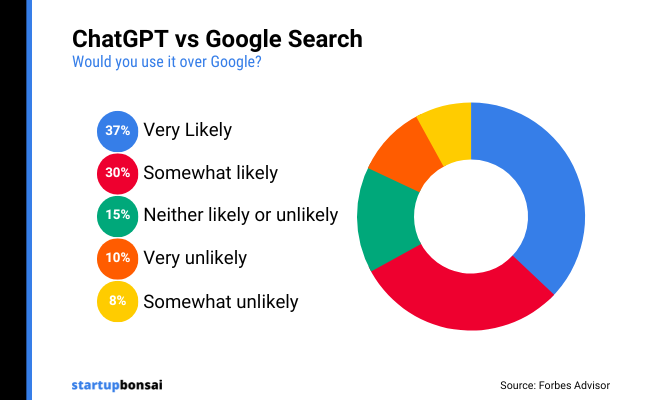
Source: Forbes Advisor2
27. Chinese company Baidu is the largest owner of AI patents in the world
Although ChatGPT is currently the biggest name in the AI industry, new technologies are in the works all the time. In fact, the Chinese company Baidu owns around 14,000 active patent families for AI technologies, suggesting we may see some revolutionary technologies emerging from the East in the next few years.
Source: Statista2
28. Investment in AI SaaS startups was expected to reach $41.5 billion by the end of last year
This is the total amount of investment expected to be secured by SaaS startups working on AI products last year. Again, this highlights just how many new AI products are in development right now—the next few years will likely see dozens of revolutionary new AI software hit the market.
Source: Stateof.ai
29. There are 292 AI unicorns in the US
This is more than any other country. And those unicorn companies have a combined enterprise value of $4.6 trillion. China comes a distant second with 69 AI unicorns, and the UK comes third with 24 AI unicorns.
Note: In business, the term ‘unicorn’ refers to privately-held startup companies valued at over $1 billion.
Source: Stateof.ai
Artificial intelligence challenges and concerns
AI has the potential to revolutionize the way we work, but the adoption of AI is not without its challenges. Here are some artificial intelligence facts and statistics that show the main challenges companies face when using AI, as well as the concerns that people have about using AI.
30. The top reason for AI project failure is technology failing to perform as expected
When asked to select the top reasons why their AI projects failed, 35% of businesses said the technology not meeting expectations was their main problem.
31% said the problem was a lack of production-ready data pipelines for diverse data sources, and a further 31% said the problem was that the results were too disruptive to their current business processes.
Source: Dataiku
31. ¾ of executives feel that a lack of AI adoption will put them out of business
The use of AI technology is growing in popularity and it’s fast becoming an essential tool for businesses. So much so, that some executives are fearful of lagging behind when it comes to AI adoption. According to Accenture, 3 out of 4 C-suite executives believe that failing to scale AI usage over the next five years could lead to their companies going out of business.
Source: Accenture
32. 76% of businesses admit to struggling with scaling the use of AI
Although many businesses are aware of the need to integrate AI tools into their regular business processes, many business owners are finding this switch difficult. 76% of respondents told Accenture that they acknowledge struggling with how to go about scaling the use of AI across their business.
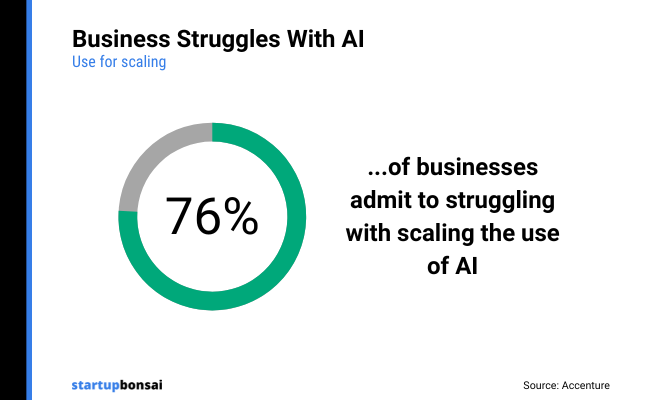
Source: Accenture
33. Ethical misuse of AI has increased 26x since 2012
This is according to the AIAAIC database, which tracks the number of AI incidents and controversies. Notable incidents of misuse include an AI-generated deepfake of Ukrainian President Zelensky surrendering.
There have also been many issues of creators using images of celebrities to create inappropriate internet content. This has led to much debate around the usage of AI and issues of consent.
Source: Stanford
34. The top barrier to AI adoption is a lack of expertise or knowledge
34% of surveyed companies highlighted this as the top thing hindering successful AI adoption. Other top barriers included the price being too high (29%), a lack of tools to develop models (25%), and projects being too complex or difficult to integrate (24%).
Source: IBM
35. 74% haven’t taken any steps to reduce bias in their AI systems
Or any other steps to ensure AI is used responsibly, for that matter. 68% haven’t taken steps to track performance variations and model drift in their AI, and 61% haven’t taken steps to make sure they can explain AI-powered decisions.
Unfortunately, this is leading to many AI systems getting a bad reputation due to inaccuracies. However, as the industry develops, companies are expected to address these issues in order to make it easier for businesses to rely on AI technology.
Source: IBM
36. 77% of people are concerned about losing their jobs to AI
One of the biggest concerns for people, especially those working in the tech industry, is AI replacing jobs. Although we may not quite be there yet, technology is improving quickly.
According to Forbes Advisor, 44% of people are very concerned, with as much as 77% of people expressing some concern. Only 6% of those surveys said they were very unconcerned.
However, at present, most companies are focusing on using AI to help employees improve productivity and processes, rather than replacing them.
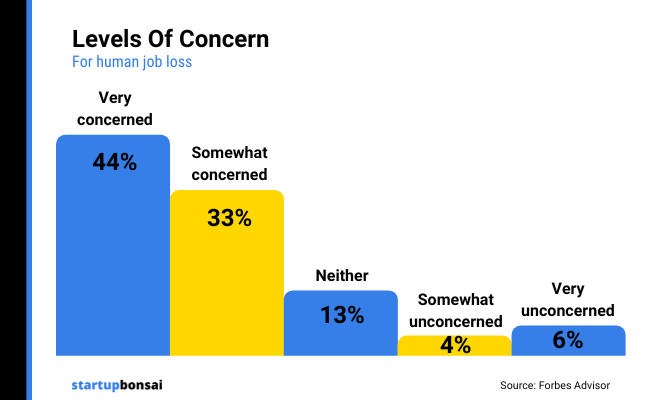
Source: Forbes Advisor2
37. 76% of people are concerned about being misinformed by AI
One of the biggest concerns people have about AI is that the information they gather will be inaccurate or biased due to its training data.
According to Forbes Advisor, over 75% of people were concerned about this, and only 4% of people said they weren’t concerned at all.
This is understandable and we’ve experienced a lot of misleading information churned out by AI tools such as Gemini and ChatGPT.
As a side note, Associated Press have issued guidelines for dealing with AI which state that any content generated by AI should be treated as an unvetted source.
Source: Forbes Advisor2
38. 14% of people are unlikely to trust businesses using AI
According to Forbes Advisor, the majority of people (65%) would still trust businesses that use AI technology. However, 14% said they were somewhat or very unlikely to trust businesses using AI. And a further 21% of respondents said that they were neutral on the subject.
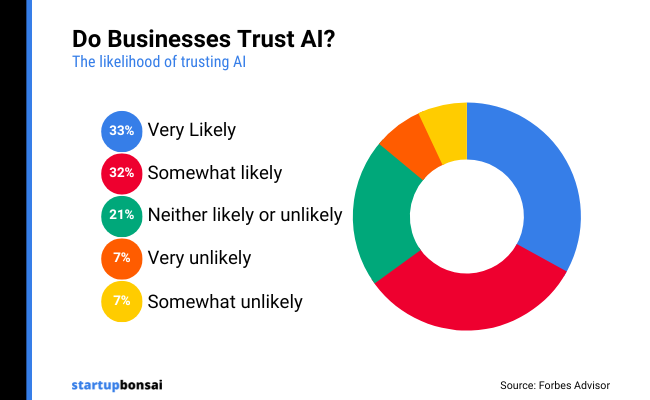
Source: Forbes Advisor2
Sources
- Accenture
- Adam Connell
- Blogging Wizard
- IBM
- Stanford
- Stateof.ai
- Statista
- Statista2
- Dataiku
- ProfitBlitz
- Reuters
- Forbes Advisor
- Forbes Advisor2
Final thoughts
And that’s a wrap—30+ interesting AI statistics that tell you everything you need to know about this emerging industry.
Interested in learning more about AI, or interested in implementing AI into your content marketing strategy? I’d recommend reading our posts on AI writing software, chatbot statistics, or marketing automation statistics.
